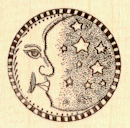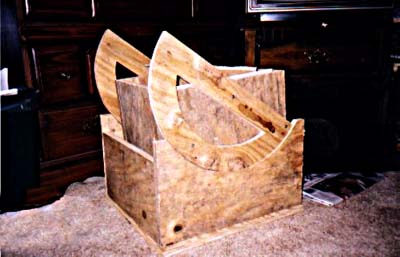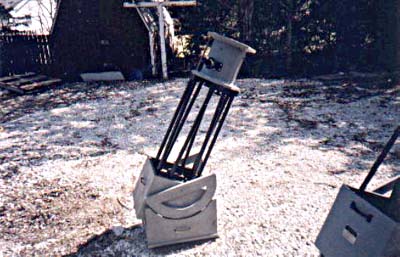 |
 |
RLO Mentoring a High School Project
As part of graduation requirements at the Bonner Springs High School, all seniors were required to complete a "senior project". The project may be of their choosing, approved by the counselors, and stages of the project must be completed according to a set time table. The project consists of a written paper and oral presentation. This particular student wrote his paper on the "Future Exploration of Mars". For his "hands on" project, he decided to build a telescope. It must be noted that the student no experience using a telescope, let alone trying to build one.
 |
In early October of 2000, the student met with the mentor, and a number of options were discussed concerning the type of telescope, the size, and some practical considerations. The student decided to make a clone of the mentors 8" f7 telescope, only scale it down to a 6" f/8. The student measured the 8" and then made drawings of all components. The mentor then advised the student on resources for optics and mechanical components. The optics and optical components were then ordered. |
While waiting for the optical components to arrive, the student quickly set forth laying out the wooden patterns, and constructing the main support structures for the optical components. Although not a necessarily difficult task, care must be taken to ensure that all parts are correctly cut and assembled according to plan. |
 |
 |
This picture shows the completed "rocker box" before final painting. The rocker box is what supports the primary mirror, and provides movement of the telescope in both altitude and azimuth. The design is known as a "Dobsonian Mount", named after the man who fostered the simple and novel design. John Dobson is a member of the San Francisco Sidewalk Astronomers. The group takes their telescopes out to the streets of San Francisco for the public to view the planets and moon. The design of the telescope allows ease of set up, portability and low maintenance. |
A multitude of components make up the final assembly. Besides the rocker box, a "cage" for the secondary mirror holder and eyepiece holder, plus connecting struts, make up the final design. For bearing surfaces (places where wood rubs against wood} telfon, formica and aluminum are used to provide a smooth movement of the telescope. Common construction materials ,most of which can be found at a local hardware store, are all that is needed for the mechanical parts of the telescope. |
 |
 |
On March 18th 2001, the telescope was completed. The student met with the mentor to do the finally assembly, fix a few problem areas, and align (collimate) the optical components. The setup took less than 5 minutes. The movement of the telescope both in altitude and azimuth was silky smooth. Although no planets or moon were visible during the daytime hours, views of trees and houses provided sharp, crisp images through the eyepieces that were purchased. Both the student and the mentor agreed this was truly a fine optical instrument, which will provide spectacular views of the planets, moon, star clusters, galaxies and nebulae! |
 |
 |

and another more recent article article dated May 2019 from the Benedictine Press Room
last updated June, 2020